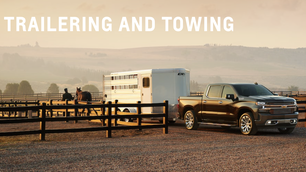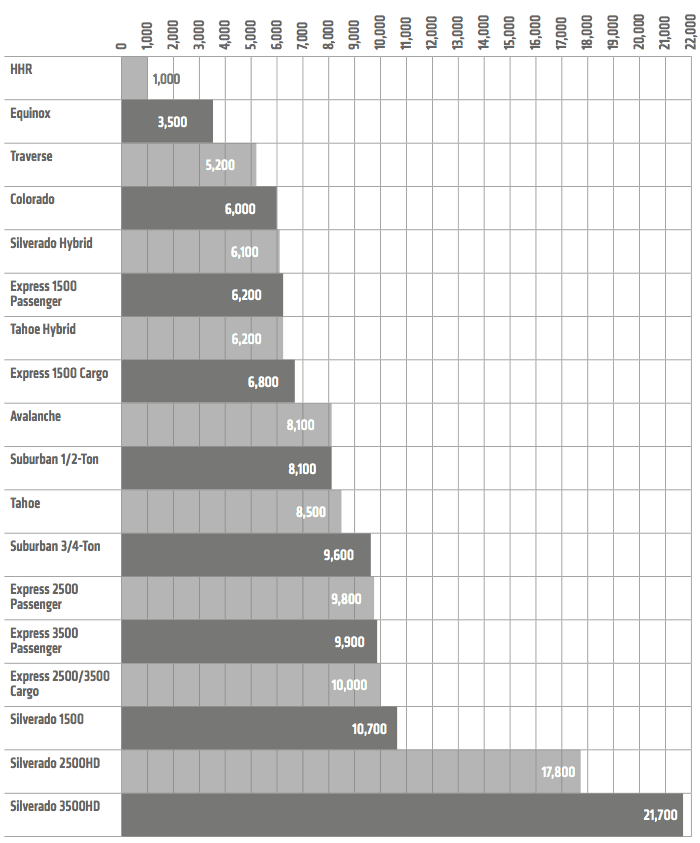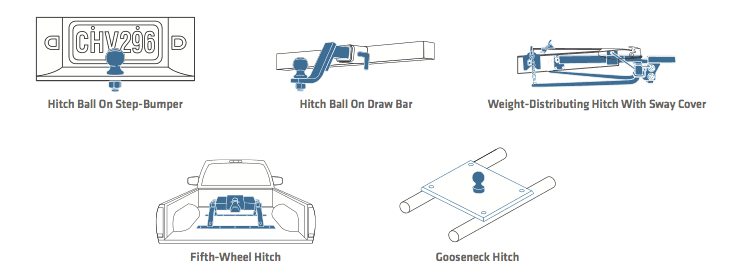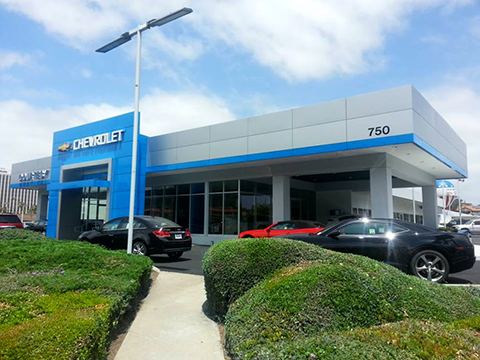 SELECTING A VEHICLE/MAXIMUM TRAILER WEIGHT RATINGS The chart below gives you an idea of the maximum amount of weight you can confidently and safely trailer with different Chevrolet models when your vehicle is properly equipped. When determining the total weight of trailer and cargo, include the weight of any additional passengers and optional equipment (driver weight and base equipment are already included). Maximum trailer weight ratings are calculated assuming a base vehicle, except for any option(s) necessary to achieve the rating, plus driver. The weight of other optional equipment, passengers and cargo will reduce the maximum trailer weight your vehicle can tow. See Courtesy Chevrolet in SAN DIEGO near Escondido, and Carlsbad for additional details. SELECTING THE RIGHT HITCH - Choosing the right hitch and making the proper electrical connections affects how your vehicle handles, corners and brakes, and allows you to alert other drivers of your intentions. Before selecting a hitch or trailering package, you should be familiar with the weight ratings specific to your Chevrolet vehicle
SELECTING TRAILERING EQUIPMENT - Most Chevrolet vehicles offer a variety of standard and available equipment for enhanced trailering performance. Aside from the equipment described below, features such as heavy-duty cooling and extendable trailering mirrors may be available. See Courtesy Chevrolet for more information on the model you're interested in. WEIGHT-CARRYING HITCH - This consists of a hitch ball mounted to a step-bumper or draw bar, commonly used for trailering light and medium loads. Hitch balls are available in a range of sizes. Make sure that the diameter of your hitch ball matches your trailer coupler. Also check that the ball meets or exceeds the gross trailer weight rating. WEIGHT-DISTRIBUTING HITCH - This is most often used for heavier trailering. This hitch type distributes the trailer load by using spring bars to shift some of the hitch weight forward onto the tow vehicle's front axle and rearward to the trailer's axles. FIFTH-WHEEL HITCH AND GOOSENECK HITCH - These are designed for heavy trailering. Located in the bed of the truck, these hitches position the trailer's kingpin weight over, or slightly in front of, the truck's rear axle. Fifth-wheel and gooseneck hitches are most frequently used with travel trailers, horse trailers and other large trailers. TRAILERING PACKAGE - An optional Heavy-Duty Trailering Equipment Package is available for a wide variety of Chevrolet models (and is standard on some Silverado and Suburban models). The Z82 Package includes a trailer hitch platform and may include other trailering equipment. WIRING HARNESS - This allows you to connect the electrical components of your trailer, such as turn signals and brake lights, to the trailering vehicle. Select Silverado models and all Avalanche, Suburban and Tahoe models feature a seven-pin wiring harness to streamline hookup of trailer lighting and brakes, and a bussed electrical center makes it easier to connect the integrated trailer brake controller. INTEGRATED TRAILER BRAKE CONTROLLER - This is optional on Silverado pickups, Suburban (standard on 3/4-ton), Tahoe (not available on Tahoe Hybrid) and Avalanche. Completely integrated within the electrical system and antilock braking system, it allows your trailer's brakes to operate simultaneously with the vehicle's brakes. TRAILER BRAKES - These are required above a 2,000-lb. trailer weight on Silverado, Tahoe, Avalanche, Suburban, and above a 1,000-lb. trailer weight on all other models. The most common trailer braking systems are surge brakes (found primarily on boat trailers) and electric brakes (often used on travel trailers, horse trailers and car haulers). Surge brakes are a self-contained hydraulic brake system on the trailer, activated during deceleration as the trailer coupler pushes on the hitch ball. An electric trailer brake system uses a brake control unit mounted inside the trailering vehicle; it operates by sensing the vehicle brakes and then applying the trailer brakes. SERIES - In general, a higher series number in a model indicates a greater load-carrying capacity. In addition, a vehicle with a higher series number typically has a stronger frame, more rigid chassis and higher-capacity brakes, increasing the vehicle's ability to trailer heavy loads. OPEN-CARGO, CLOSED-CARGO VEHICLES - There are two types of Chevrolet vehicles: open-cargo (Silverado and Colorado), designed primarily for carrying lots of cargo; and closed cargo (Traverse, Tahoe, Suburban, Avalanche, Express and Equinox) for carrying both cargo and passengers. The multipurpose capabilities of our full range of closed-cargo vehicles make them good choices for drivers with broad driving requirements. Click here for more information.
0 Comments
Your comment will be posted after it is approved.
Leave a Reply. |
Welcome to the Courtesy Chevrolet blog – your place for Chevrolet news and reviews. Brought to you by Courtesy Chevrolet.
Website: CourtesySanDiego.com Phone: (619) 373-1641 LocationClick map to enlarge
Centrally located at 750 Camino Del Rio, North San Diego, CA 92108 Click here for our hours Find Us On FacebookFollow Courtesy Chevrolet on TwitterRead Our DealerRater Customer Reviews
Archives
May 2024
Categories
All
Produced by 72 Advertising
|
Courtesy Chevrolet. Centrally located at 750 Camino Del Rio, North San Diego, CA 92108









 RSS Feed
RSS Feed